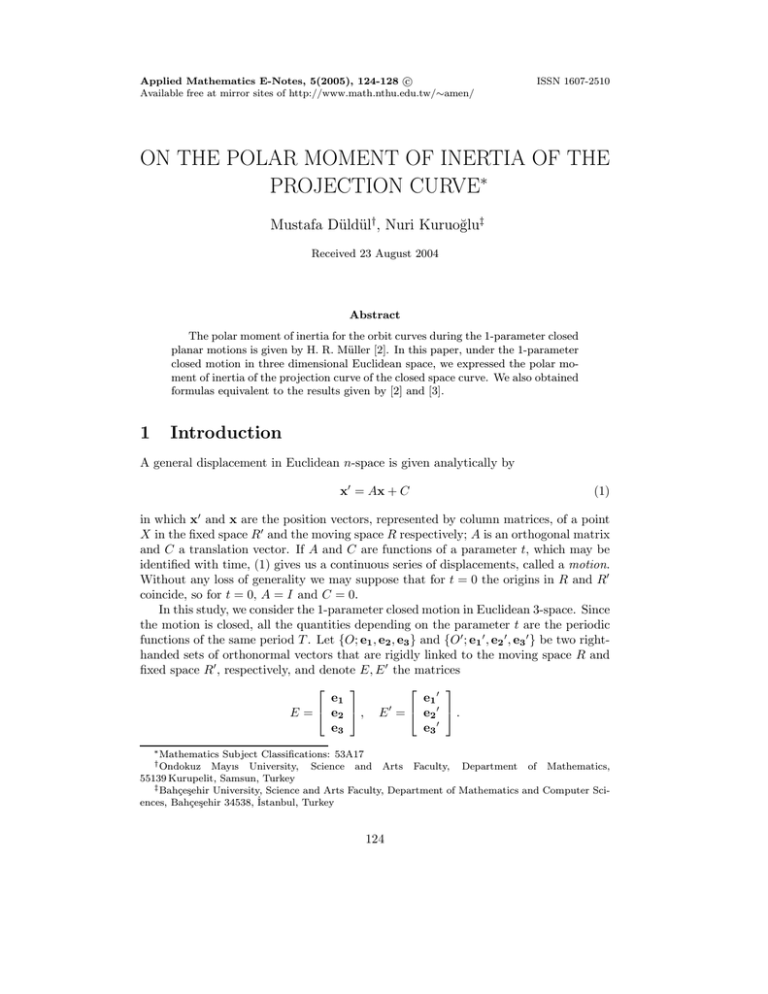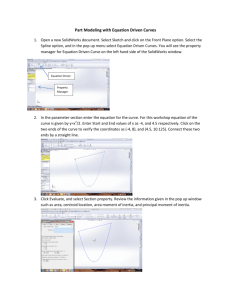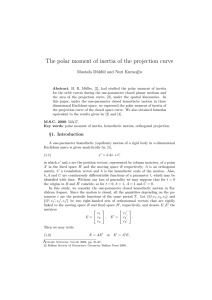Document 10285467
advertisement

Applied Mathematics E-Notes, 5(2005), 124-128 c
Available free at mirror sites of http://www.math.nthu.edu.tw/∼amen/
ISSN 1607-2510
ON THE POLAR MOMENT OF INERTIA OF THE
PROJECTION CURVE∗
Mustafa Düldül†, Nuri Kuruoğlu‡
Received 23 August 2004
Abstract
The polar moment of inertia for the orbit curves during the 1-parameter closed
planar motions is given by H. R. Müller [2]. In this paper, under the 1-parameter
closed motion in three dimensional Euclidean space, we expressed the polar moment of inertia of the projection curve of the closed space curve. We also obtained
formulas equivalent to the results given by [2] and [3].
1
Introduction
A general displacement in Euclidean n-space is given analytically by
x3 = Ax + C
(1)
in which x3 and x are the position vectors, represented by column matrices, of a point
X in the fixed space R3 and the moving space R respectively; A is an orthogonal matrix
and C a translation vector. If A and C are functions of a parameter t, which may be
identified with time, (1) gives us a continuous series of displacements, called a motion.
Without any loss of generality we may suppose that for t = 0 the origins in R and R3
coincide, so for t = 0, A = I and C = 0.
In this study, we consider the 1-parameter closed motion in Euclidean 3-space. Since
the motion is closed, all the quantities depending on the parameter t are the periodic
functions of the same period T . Let {O; e1 , e2 , e3 } and {O3 ; e1 3 , e2 3 , e3 3 } be two righthanded sets of orthonormal vectors that are rigidly linked to the moving space R and
fixed space R3 , respectively, and denote E, E 3 the matrices
⎤
⎤
⎡
⎡
e1
e1 3
E = ⎣ e2 ⎦ , E 3 = ⎣ e2 3 ⎦ .
e3
e3 3
∗ Mathematics
Subject Classifications: 53A17
Mayıs University, Science and Arts Faculty, Department of Mathematics,
55139 Kurupelit, Samsun, Turkey
‡ Bahçeşehir University, Science and Arts Faculty, Department of Mathematics and Computer Sciences, Bahçeşehir 34538, İstanbul, Turkey
† Ondokuz
124
M. Düldül and N. Kuruoğlu
125
Then we may write
E = AE 3
or E 3 = At E,
(2)
where A is a positive orthogonal 3 × 3-matrix and the superscript “t” indicates the
transpose. Since A ∈ SO(3) we may write
AAt = I,
where I is the unit matrix. This equation, by differentiation with respect to t, yields
dA.At + A.dAt = 0,
which shows that the matrix
Ω = dA.At
is antisymmetric. We may write
⎡
0
Ω = ⎣ −w3
w2
w3
0
−w1
⎤
−w2
w1 ⎦ ,
0
where wi , i = 1, 2, 3, are the linear differential forms with respect to t, i.e. wi = fi (t)dt.
Differentiation of (2) with respect to t yields
dE = ΩE
or
dei = wk ej − wj ek ,
(i, j, k = 1, 2, 3; 2, 3, 1; 3, 1, 2).
(3)
Then, we may write
dei = ω × ei ,
where
ω = w1 e1 + w2 e2 + w3 e3
is called the rotation vector of the motion and “ × ” denotes the vector product.
2
The Polar Moment of Inertia of the Projection
Curve
I.
Let X be a fixed point in R with
OX = x = x1 e1 + x2 e2 + x3 e3 .
126
Polar Moment of Inertia
If we denote
OO3 = u = u1 e1 + u2 e2 + u3 e3 ,
for the position vector of X in R3 we may write
O3 X = x3 = x − u.
(4)
The point X describes a closed curve (X), its path, in R3 during the 1-parameter
closed motion. The projection of this closed path, in the direction of a fixed unit vector
e3 , on any plane P is a closed curve, say (X n ). We suppose that the curve (X n ) is
uniformly covered with the mass elements
dm = ||ω n ||dt = |cosθ|ωdt,
where ω = ||ω|| is the instantaneous angular velocity of the motion, ω n is the normal
component of ω to the plane P and θ = θ(t) is the angle between the vectors ω and e3 .
For the projection of x3 in the direction of e3 on P , we have
xn = x3 − < e3 , x3 > e3 ,
(5)
where xn is the position vector of the projection point X n of X 3 ∈ R3 and “ <, > ”
denotes the scalar product. Thus, the polar moment of inertia of the curve (X n ) with
respect to the origin O3 of R3 (O3 ∈ P ) is
MX =
||xn ||2 dm,
(6)
where the integration is taken along the closed curve (X n ).
If we substitute (5) into (6), for the polar moment of inertia of the projection curve
of (X) we obtain
T
MX =
0
||x3 ||2 − (< e3 , x3 >)2 |cosθ|ωdt,
(7)
where the integration is taken along the closed curve (X).
Let the direction of projection in R3 is given by the unit vector e3 = a1 e1 + a2 e2 +
a3 e3 . Then, if we substitute (4) into (7), we get
3
MX = MO + σ
i=1
3
x2i −
3
bij xi xj +
i,j=1
ci xi ,
(8)
i=1
where
T
σ=
0
T
|cosθ|ωdt,
bij =
0
T
ai aj |cosθ|ωdt,
ci = 2
0
⎧
⎨
a
⎩ i
3
j=1
aj uj − ui
⎫
⎬
⎭
|cosθ|ωdt
and MO is the polar moment of inertia of the projection curve of the orbit curve (O).
M. Düldül and N. Kuruoğlu
127
We may give the following theorem.
THEOREM 1. Let us consider the 1-parameter closed motions of Euclidean 3-space.
If the projection curves (in the direction of a unit vector e3 ) of closed point paths have
equal polar moment of inertia, then such points lie on the same sphere.
SPECIAL CASE. In the case of θ(t) ≡ 0, the paths are planar. Thus, we obtain
the polar moment of inertia given by Müller, [2].
II.
Let X and Y be two fixed points in R and Z be another point on the line segment
XY . Then we may write
zi = λxi + ξyi ,
λ + ξ = 1.
(9)
Using (8), we get
MZ = λ2 MX + 2λξMXY + ξ 2 MY ,
(10)
where
⎧
⎫
3
3
⎬
1⎨
= MO + σ
xi yi +
ci (xi + yi ) −
bij (xi yj + xj yi )
⎭
2 ⎩ i=1
i=1
i,j=1
3
MXY
(11)
is called the mixture polar moment of inertia of the projection curves of (X) and (Y ).
It is clearly seen that MXY = MY X and MXX = MX .
Since
3
MX − 2MXY + MY = σ
we can rewrite (10) as follows:
⎧
⎨
MZ = λMX + ξMY − λξ σ
⎩
3
i=1
(xi − yi )2 −
3
i,j=1
bij (xi − yi )(xj − yj ),
3
(xi − yi )2 −
.
(13)
We will define the distance D(X, Y ) between the points X, Y of R by
⎧
⎫
3
⎨ 3
⎬
D2 (X, Y ) = ε σ
(xi − yi )2 −
bij (xi − yi )(xj − yj ) , ε = ∓1.
⎩
⎭
(14)
i=1
i=1
i,j=1
bij (xi − yi )(xj − yj )
⎫
⎬
(12)
⎭
i,j=1
By the orientation of the line XY we will distinguish D(X, Y ) = −D(Y, X). Therefore,
from (13) we have
MZ = λMX + ξMY − ελξD2 (X, Y ).
(15)
128
Polar Moment of Inertia
Since X, Y and Z are collinear, we may write
D(X, Z) + D(Z, Y ) = D(X, Y ).
Thus, if we denote
λ=
D(Z, Y )
,
D(X, Y )
ξ=
D(X, Z)
,
D(X, Y )
from (15) we get
MZ =
1
{D(Z, Y )MX + D(X, Z)MY } − εD(X, Z)D(Z, Y ).
D(X, Y )
(16)
The equivalent result for planar kinematics is given by Müller, [2].
Now, we consider that the points X and Y trace the same closed space curve. In
this case, for the projection curves in the direction of e3 we have MX = MY . Then,
from (16) we obtain
MX − MZ = εD(X, Z)D(Z, Y ).
(17)
Thus, we have Holditch-type result1 , [1], for the polar moments of inertia of projection
curves. The equivalent result for projection areas under the 1-parameter closed spatial
motions is given by [3]. So, we may give the following theorem.
THEOREM 2. Let us consider a line segment with the constant length. If the
endpoints of the line segment trace the same space curve in R3 , then a different point
on this segment traces another space curve. The difference between the polar moments
of inertia of the projection curves (in the direction of unit vector e3 ) of these space
curves depends on the distances (in the sense of (14)) of the chosen point from the
endpoints.
Acknowledgment. The first author would like to thank TÜBİTAK-BAYG for
their financial supports during his doctorate studies.
References
[1] H. Holditch, Geometrical theorem, Q. J. Pure Appl. Math., 2(1858), 38.
[2] H. R. Müller, Über Trägheitsmomente bei Steinerscher Massenbelegung, Abh.
Braunschw. Wiss. Ges., 29(1978), 115—119.
[3] H. R. Müller, Erweiterung des Satzes von Holditch für geschlossene Raumkurven,
Abh. Braunschw. Wiss. Ges., 31(1980), 129—135.
1 The classical Holditch Theorem: If the endpoints X, Y of a segment of fixed length are rotated
once on an oval, then a given point Z of this segment, with XZ = a, ZY = b, describes a closed, not
necessarily convex, curve. The area of the ring-shaped domain bounded by the two curves is πab.







